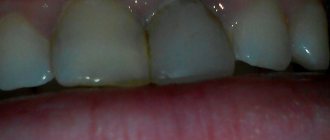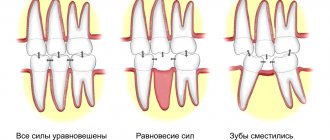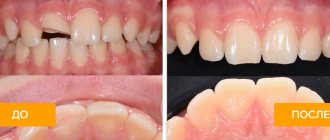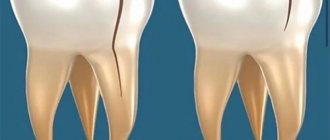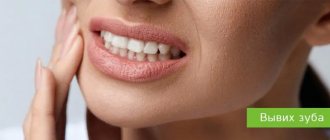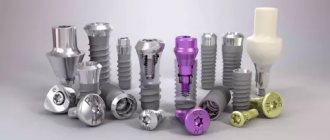Mechanical damage to a tooth due to injury without violating its integrity is called a bruise. This type of injury is common in children and adults, especially athletes. According to statistics, among all injuries to primary teeth, bruises account for 2.5%; bruises of permanent teeth account for 1.5% of the total number of traumatic injuries in the permanent dentition.
Even if the tooth looks unchanged after a bruise, it is necessary to visit a dentist to prevent the development of complications associated with the injury.
Symptoms
A strong blow to a tooth is accompanied by damage to periodontal tissue, and some fibers and small blood vessels rupture. There are no visible structural damage to the tooth; upon visual inspection, it appears intact. After a bruise, the tooth remains motionless, and minor mobility is rarely observed. The gums in the area of the injured tooth swell.
In the first hours after the impact, patients experience pain in the tooth, which intensifies when biting; the pain is aching in nature. The tooth feels high, and slight bleeding may occur from under the gum near it. When a bruise occurs, the neurovascular bundle of the tooth can be damaged, that is, the pulp is injured, and hemorrhage occurs in the pulp chamber, and the enamel becomes pink in color. A severe bruise can lead to the death of the pulp.
Often, when a bruise occurs, cracks appear on the tooth enamel, which can only be detected with a special examination.
IF A CHILD KNOWS OUT A MILK TOOTH
- Due to the small age of the child, additional technical difficulties immediately arise, therefore, the knocked out tooth, if it has fallen out, should be placed immediately in cow’s milk.
- You need to get to the dentist within 30 minutes.
- There is a possibility that the dentist will refuse to replant a baby tooth, citing the patient’s young age and a change of teeth in the near future, that is, the inappropriateness of the procedure. But baby teeth are also subject to replantation, remember this. If you're lucky, the dentist will turn out to be sane and believes in miracles, and the tooth will be a vigorous, lively person; the child will implant the tooth. Need to try.
The dentist will do additional fixation, prescribe physical procedures, the tooth will take root - that’s elementary.
Diagnostics
- Patients with a tooth injury are referred for x-ray diagnostics to exclude a root fracture. To obtain information using targeted radiography, it is sometimes necessary to take several images from different angles, which is undesirable for the patient.
The most accurate information about the condition of the roots is provided by computed tomography - an x-ray examination method that allows you to obtain a three-dimensional image of the tooth. The examination results are displayed on the computer screen and must be transferred to a CD or USB flash drive.
An X-ray examination of a tooth bruise reveals a slight widening of the periodontal fissure.
- The condition of the pulp after injury is monitored using EDI - electroodontodiagnosis. The method consists in determining the reaction of the nerve endings of the pulp to the influence of electric current. The level of electrical excitability of the pulp depends not only on its condition, but also on the degree of formation of the tooth root.
The examination is carried out 2 or 3 days after the injury, since on the first day the pulpal response may be reduced due to traumatic neuritis. Be sure to perform an electrical test on adjacent healthy teeth to compare sensitivity levels. 3-4 weeks after the injury, EDI is repeated.
- Another method of examination for a tooth bruise is transillumination, the essence of which is to pass a beam of cold light through the tooth and evaluate shadow formation. If there are cracks in the enamel after an impact, they will be clearly visible in the stream of light; The technique also helps to detect pulpitis. In modern clinics, all dental units are equipped with light guides for transillumination examination.
Treatment of injuries to teeth and gums in children
Has the tooth been hit (bruised, dislocated) or has become loose? Be sure to see a dental surgeon. It doesn’t matter at all that the tooth looks intact. A root may be broken or a nerve damaged. Such a tooth can be saved.- Is a temporary (baby) tooth knocked out? We are not talking about saving it and installing it back. After all, the jaw contains the germ of a permanent tooth and the main thing is not to injure it. It is necessary to close any access of infection to the permanent tooth germ, so a doctor’s examination is necessary.
- The tooth’s growth has not yet finished – is it possible to restore it? Don't believe the myths that immature teeth cannot be restored! Special restoration techniques do not affect the further growth and formation of the tooth. On the contrary, tightness and the absence of infection ensure full growth and formation of the tooth. We have many years of experience of the best domestic and foreign traumatologists, serious and reliable research on our side.
Diagnosis of tooth trauma
Often, one medical examination is not enough to understand how damaged the tooth, its roots, the tissue surrounding the tooth, or the germ of a permanent tooth are, if we are talking about a primary bite. A computed tomography scan or a targeted image of an injured tooth will allow you to make a correct diagnosis in time and begin saving the injured tooth. Medfodent Plus specialists are armed with the best methods for treating dental trauma. Together with you, we will do everything possible to keep the injured tooth healthy!
Gum injury, treatment
The gums are part of the oral mucosa. The gums consist of very delicate and vulnerable tissues, and therefore are often injured, especially in children who, for research purposes, often carry into their mouths any objects that come into their hands.
A child can injure the oral mucosa if he falls, hits a hard object, or hits his own teeth due to injury.
Injury to the oral mucosa can also occur as a result of the child’s bad habits: biting the cheek, the inside and outside of the lips, etc.
Discomfort or pain in the gum area can also occur after treatment, when treatment is carried out in a very inconvenient and hard-to-reach place, or when the tooth is severely damaged and caries is at or even below the level of the gum. In this case, in order to properly treat the tooth, the dentist is forced to push back the gum mucosa and isolate it from the tooth tissue.
The oral mucosa is saturated with blood vessels, and therefore injury may be accompanied by swelling and bleeding. However, as a rule, the mucous membrane heals quickly without serious consequences. Of course, injury to the oral mucosa and gums is a reason for an urgent visit to a pediatric dental clinic. A specialist - a pediatric dentist or a dental surgeon - will assess the severity of the injury, treat the wound surface with disinfectant solutions that will not cause additional harm to the delicate mucous membrane, and also discuss some home procedures: rinsing, treatment with a special dental paste, and, if indicated, oral medications, incl. h. painkillers and inflammation relievers.
Treatment of tooth or gum injury
If a child suffers a tooth injury, it is worth taking him to a pediatric dental clinic as quickly as possible (unless the child requires more urgent care that requires hospitalization). The choice of a clinic in this case should be based on the willingness of the attending physician to work with the injury and save the teeth (tooth) that can be saved. Often an injury requires medical observation for quite a long time, following recommendations such as a gentle diet, rest and immobilization for the injured tooth.
Complications after injury
With bruises, the prognosis is usually favorable, but in some cases the injury can lead to the following complications:
- Darkening of the enamel. After a bruise, the cause of darkening is hemorrhage into the pulp chamber: the pink color of the tooth darkens over time, the enamel acquires a brownish or gray tint. Depulped teeth tend to darken due to the fact that metabolic processes in them stop, the teeth become “dead”, and the enamel becomes dull.
- The death of the pulp leads to the development of pulpitis: the pulp decomposes, inflammation develops in the tooth, which without treatment turns into periodontitis.
- Periodontitis is inflammation of periodontal tissue. It can be: post-traumatic, occurring a short time after the injury; chronic, develop as a consequence of pulpitis. When a purulent infection occurs, there is a high risk of tooth loss and purulent blood poisoning.
- The appearance of a post-traumatic odontogenic cyst at the root apex during the development of post-traumatic periodontitis.
- Stopping the development of roots of permanent teeth in children.
- In case of injury to milk teeth, the following are possible: disruption of the formation of the rudiments of permanent teeth, their death.
Types of anterior tooth injuries
Most often, it is the front teeth that are injured. There are several common types of injuries.
- Dislocation
Tooth luxation is diagnosed when it is damaged and displaced with trauma to periodontal tissue. It is considered the most common injury to the front teeth in children, since baby teeth are much less resistant to such damage than permanent teeth in adults. Symptoms of luxation are displacement of the tooth from the dentition, periodontal inflammation, bleeding, pathological tooth mobility and severe pain. If the dislocation is incomplete, the doctor can set the tooth back in place; also, with minor damage, the tooth can recover on its own. Complete dislocation requires the tooth to be removed or replaced in its place.
To place the tooth in its proper place, the doctor uses an anesthetic injection. After repositioning, the dentist performs fixation using splinting. The immobility of an injured tooth is ensured by ligatures, mouth guards, staples and other structures that perform the functions of a splint. It is very difficult to fix baby teeth that have insufficiently formed roots. Therefore, in children under two or three years of age, a tooth damaged by dislocation is usually removed.
- Injury
A bruise is a closed injury to tooth tissue. It is characterized by pain during mechanical stress, including chewing, and post-traumatic tissue swelling. Treatment of a bruise consists of grinding the edge of the antagonist tooth and breaking the bite using a special mouthguard or plate. The injured tooth should be kept at rest; solid food should be excluded from the diet for several weeks. If the bruise is accompanied by pulp death, long-term endodontic treatment is necessary.
- Tooth fracture
When a tooth is damaged with a change in the integrity of hard tissues, it is called a fracture. Fractures of the crowns of anterior teeth in children are quite common. A fracture is accompanied by a chipped tooth, pain and bleeding. Treatment for a fracture will depend on the extent of the damage. In case of injury to a baby tooth, the fracture line is fixed with cement and the tooth is left until it is replaced with a permanent dentition. If the tooth is permanent and can be saved, the missing tooth fragment is restored using modern composite materials. However, this presents a certain difficulty - if the roots have not yet formed, you must first protect the pulp and provide normal conditions for root development, and only then deal with the elimination of the aesthetic defect.
Treatment
- For mild bruises, treatment consists of resting the tooth for 3-4 weeks by reducing the load during chewing: the menu includes soft and semi-liquid foods, and a blender is used to grind hard foods.
- To ensure rest for baby teeth, temporary bite separation with the help of mouth guards is used; if a permanent tooth is bruised, splinting is performed. The splint allows you to immobilize an injured tooth and redistribute the load during chewing onto healthy teeth.
- If the pulp dies due to an impact, the tooth cavity is opened and the pulp is removed, after which the root canals are filled and a permanent filling is installed. If the crown of a tooth darkens, it can be whitened.
- When a baby tooth is bruised, grinding of the cutting edge of the crown of the antagonist tooth is used to prevent tooth contact and reduce pain. This method is not used for permanent teeth.
- To relieve pain, it is recommended to take an anesthetic tablet (ibuprofen, ketorolac, nimesulide) and apply an anesthetic gel (Dentol, Kamistad) to the gums around the tooth.
- When swelling of the soft tissues of the face accompanies a bruise, cold compresses are applied: a plastic bottle with cold water (not lower than +4°C) is wrapped in a cloth and held on the area of swelling for 15-20 minutes.
- A course of magnetic laser therapy is carried out - a combined effect on injured tissue of a magnetic field and low-intensity laser radiation. The method helps improve healing processes, relieves swelling and inflammation. The course consists of 10 daily procedures lasting 5 minutes.
- UHF therapy is indicated to accelerate tissue regeneration.
Tooth root fracture
A tooth root fracture always has more severe consequences. The child complains of pain. Bleeding is not always observed, especially if the integrity of the gums is preserved. The crown may be intact, but there is always mobility and sometimes a change in the location of the tooth.
Baby teeth with a root fracture must always be removed. Treatment of permanent teeth depends on where in the root the fracture occurred. If the root fracture occurs deeper than 4 mm under the gum, the tooth must be removed. In other cases, it is necessary to remove tooth fragments, treat root canals and plan restoration. There is no need to be afraid of having baby teeth removed. At the Family Dentistry Center, treatment and removal of teeth under anesthesia during sleep is available.
Prevention
To prevent dental injuries, you must:
- Observe safety precautions at work, arrange the workplace and carry out potentially hazardous work in accordance with established rules.
- Properly equip playrooms for children and supervise children while playing.
- Follow traffic rules and use seat belts when traveling, as even minor emergency braking of the car carries a high risk of injury.
- Avoid conflict situations that lead to fights.
- Ensure the safety of sports games using special equipment (helmets, masks, dental guards).
- Carefully select sports grounds: they must comply with safety requirements.
